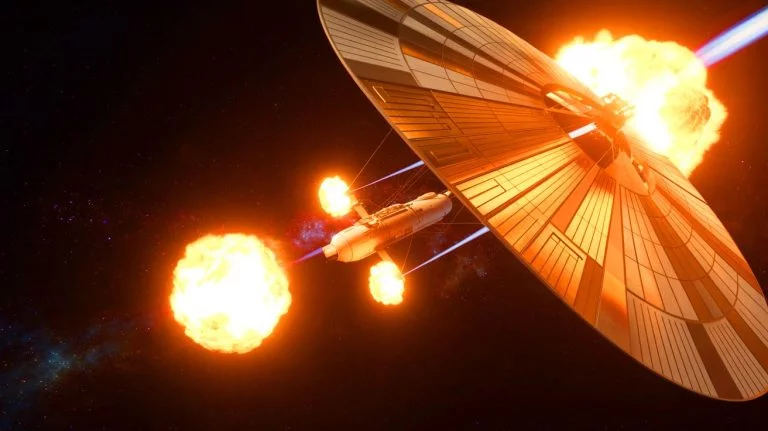| IN A NUTSHELL |
|
Imagine sending a spacecraft hurtling through the cosmos at 1% of the speed of light, a speed so extraordinary it defies current technological paradigms. This ambitious vision stems from the fusion of nuclear explosions and solar sails—a concept previously confined to the realm of science fiction. Inspired by the “Three-Body Problem,” this idea proposes leveraging the immense energy released by a thousand nuclear detonations to propel a probe into the vast expanse of space. As humanity stands on the brink of interstellar exploration, this concept invites us to explore the boundaries of scientific possibility.
Harnessing Nuclear Warheads for Space Travel
The notion of propelling a spacecraft using nuclear warheads might sound like a plot twist from a futuristic novel. However, according to André Füzfa, a professor at the University of Namur, Belgium, this idea is scientifically “plausible.” His extensive calculations reveal that the approximately 15,000 nuclear warheads available globally contain a combined energy of about 10 exajoules. This colossal energy reserve could, in theory, propel a 25-ton spacecraft to a staggering 10% of the speed of light.
This concept finds its roots in the Medusa Project, formulated by American physicist Johndale C. Solem in the 1990s. Despite its theoretical feasibility, implementing such a plan poses immense technological challenges. The primary hurdle involves ensuring the reliable deployment of nuclear charges into orbit. With current rocket launch failures at 5%, an alarming 50 out of 1,000 bombs could disastrously detonate in the atmosphere.
The Challenges of Propelling a Solar Sail
A solar sail designed for such a mission must possess an exceedingly high reflective index to minimize damage from radiation absorption. Achieving precise targeting is another formidable challenge. André Füzfa illustrates this point by noting that an error of merely 1/3600 of a degree in initial orientation could result in missing a target 400 trillion kilometers away by billions of kilometers.
In addition, developing ultra-durable materials is crucial to withstand the approximately 2,000 g of near-instantaneous acceleration and the erosive force of stellar winds, which transform into high-intensity ionizing radiation at such velocities. Even a minor failure, such as a cable detaching from the sail, could lead to a catastrophic mission failure.
To encapsulate this concept, the “Escalier” project envisions launching a probe equipped with a solar sail into space, where it would be propelled further by a series of nuclear detonations strategically placed along its path.
Technological and Ethical Implications
While the technical hurdles are immense, the ethical implications of using nuclear explosions for space travel cannot be ignored. The potential for atmospheric detonation poses environmental risks that could have global repercussions. The international community would need to establish robust frameworks to govern the deployment of nuclear technology in space, ensuring that such advancements do not compromise planetary safety or violate existing treaties.
Moreover, the pursuit of this technology raises profound ethical questions about the militarization of space. The prospect of deploying nuclear warheads beyond Earth’s atmosphere may blur the lines between peaceful exploration and weaponization, necessitating global dialogue on the future of space exploration.
The Future of Interstellar Exploration
The concept of using nuclear explosions and solar sails to achieve unprecedented speeds is not just a technological challenge; it’s a gateway to interstellar exploration. As humanity looks beyond our solar system, these innovative propulsion methods could pave the way for reaching distant stars and potentially habitable exoplanets. This endeavor represents a monumental step in our quest to understand the universe and our place within it.
However, the journey toward realizing this vision requires international collaboration, technological breakthroughs, and a commitment to ethical exploration. The dream of reaching the stars is within our grasp, but it demands careful consideration of the risks and rewards.
As we stand on the brink of a new era in space exploration, we must ask ourselves: Are we ready to embrace the challenges and opportunities that come with pushing the boundaries of human innovation?
Did you like it? 4.5/5 (22)







Wow, this sounds like something out of a sci-fi movie! 🚀
Isn’t there a risk of detonating nuclear bombs in space? 😬
Thanks for the article! It’s fascinating to think we might be able to travel at 10% of the speed of light.
How will this concept handle the ethical concerns of militarizing space?
What happens if one of these nuclear explosions doesn’t go as planned? 😨
Interesting read! But surely, there must be safer propulsion methods we can explore?
This seems like a huge leap, are we technologically ready for this?